 |
Civil War Battles |
|
State War Records |
| AL - AK - AZ - AR - CA - CO - CT - DE - FL - GA - HI - ID - IL - IN - IA - KS - KY - LA - MA - MD - ME - MI - MN - MS - MO - MT - NE - NV - NH - NJ - NM - NY - NC - ND - OH - OK - OR - PA - RI - SC - SD - TN - TX - UT - VT - VA - WA - WV - WI - WY |
The Battle of Allatoona
October 5, 1864 in Allatoona, Bartow County, Georgia
 |
|||||||||||||||||||||
|
The Union’s main supply depot was established at Allatoona. By the fall of 1864, the site warehoused at least 1,000,000 rations of hardtack and approximately 9,000 head of cattle were pastured just to the north.
Allatoona’s strategic importance was enhanced after the Atlanta Campaign. Before the Battle of Atlanta, Maj. Gen. John B. Hood replaced Gen. Joseph Johnston in command of Confederate forces in Georgia. After Atlanta fell, Hood launched a campaign to re-capture Nashville. His decision to drive north necessitated that the Confederates break Maj. Gen. William T. Sherman’s line of supplies and communication, and the best place to do that was to severe the Western & Atlantic Railroad lines at Allatoona Pass. A Confederate assault on the forts at Allatoona would be the first battle in Hood’s disastrous Nashville Campaign.
On October 2-4, Hood attacked a number of minor garrisons and damaged track during. Sherman fretted over the situation at Allatoona, 13 miles northwest of Kennesaw. From his position, he could see that the small town was being surrounded by Confederates. Since the telegraph wires north of Marietta had been cut, Sherman had sent the orders to Corse by signal. At this point, he couldn't be certain that Corse had received them and was on his way to reinforce Allatoona. Messages sent to Allatoona on the afternoon and evening of the 4th went unanswered. Sherman sent reinforcements—John M. Corse's brigade—to Allatoona just before the Confederates attacked there. Maj. Gen. Samuel G. French's Confederate division arrived near Allatoona at sunrise on October 5.
French knew before daylight that he could not charge the 2 slopes from the south. He marched his 3 brigades around to the north and west, where he planned to make his assault.
On October 5, at 6:00 A.M., the opening of the battle of Allatoona began with Confederate artillery fire, which had been placed 1,500 yards north of the cut and on a ridgeline. French then moved in for the main attack. Under a brisk cannonade, French worked a brigade around to the north of Corse, while keeping up skirmish fire on his west and south fronts. With the Cartersville Road sealed, French then cut the telegraph and the railroad, effectively sealing Corse off from outside communications. Assuming he had every advantage, French then sat down to write a message to his adversary.
Shortly after 8 A.M., a Confederate officer walked down the Cartersville Road under a flag of truce. He carried French's message to Corse, which read: "Sir; I have placed the forces under my command in such a position that you are surrounded, and to avoid a needless effusion of blood, I call on you to surrender your forces at once and unconditionally. Five minutes will be allowed you to decide. Should you accede to this, you will be treated in the most honorable manner as prisoners of war." Though Corse could clearly see he was outnumbered, he also had confidence in his officers and the men they commanded. He wasn't about to capitulate without a fight. After receiving a negative reply, French attacked.
From the north and west, French's division filled every hollow and broken piece of ground that afforded shelter, firing into the ditches around the fort. As French tightened the noose around the western redoubt, it meant almost certain death for those Union troops who raised their heads above the parapet walls. But the Confederates could make little progress or come within 100 yards of the fort, as a battery laid down a deadly fire. It was now past 2:00 P.M. and French had decided he'd almost had enough. The Union outer line survived a sustained 2 1/2-hour attack, but then fell back and regrouped in an earthen "Star" fort of Allatoona Pass.
French repeatedly attacked, but the fort held. The Confederates began to run out of ammunition, and reports of arriving Union reinforcements influenced them to move off and rejoin Hood's force.
French reformed his men behind Young's brigade in preparation for a retreat. When Corse observed these movements he believed the Confederates were preparing for another assault. Placing an artillery piece in an embrasure, he threw a few shots into French's troops. When the Confederates scrambled for cover, Corse rallied his men to a small counterattack. This was all French needed to make the decision to withdraw.
Sherman, who was still atop Kennesaw, could see the fire from the battle in the distance. Shortly after 2:00 P.M., he noted the firing had subsided and feared Corse had been overwhelmed. By 4:00 P.M., French had withdrew entirely from the battlefield, leaving Corse and his determined garrison still in possession of the redoubts and the one-million rations stored in the town.
The Battle of Allatoona Pass was the introduction of Hood's ill-fated Nashville Campaign. It would be the last great Confederate offensive of the Civil War. Within 6 weeks Sherman would launch his "March to the Sea" from Kingston, a few miles west of Allatoona.
While the defense of Allatoona inspired Union forces, it served only to dishearten the Confederate army, who desperately needed a boost of morale. The rations would have been invaluable to Hood's hungry soldiers, but instead Allatoona was added to the growing list of Hood's failures.
